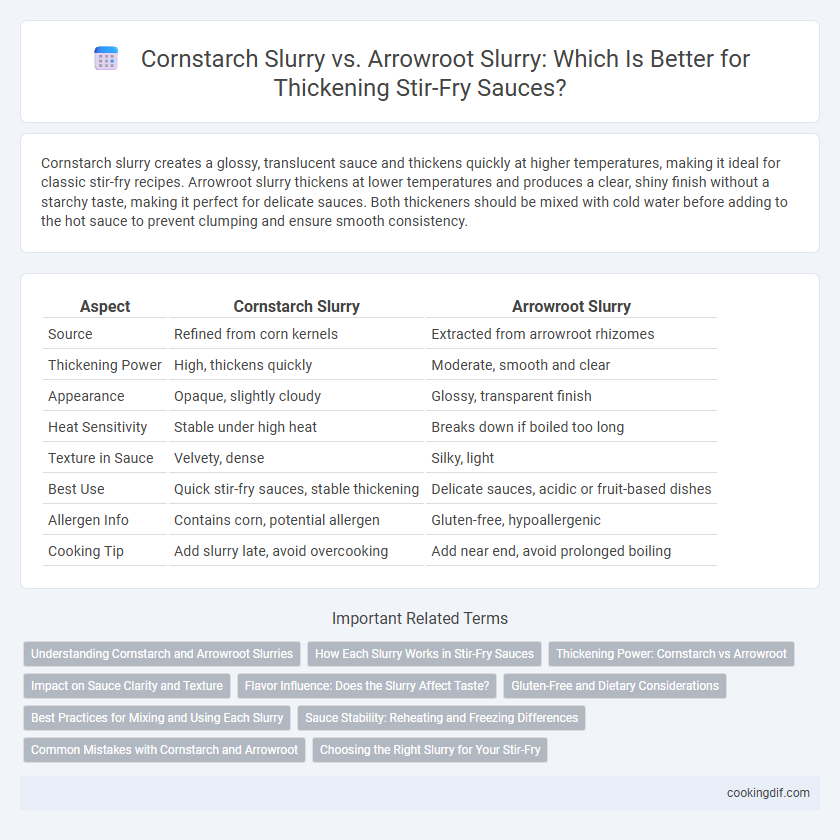Cornstarch slurry creates a glossy, translucent sauce and thickens quickly at higher temperatures, making it ideal for classic stir-fry recipes. Arrowroot slurry thickens at lower temperatures and produces a clear, shiny finish without a starchy taste, making it perfect for delicate sauces. Both thickeners should be mixed with cold water before adding to the hot sauce to prevent clumping and ensure smooth consistency.
Table of Comparison
| Aspect | Cornstarch Slurry | Arrowroot Slurry |
|---|---|---|
| Source | Refined from corn kernels | Extracted from arrowroot rhizomes |
| Thickening Power | High, thickens quickly | Moderate, smooth and clear |
| Appearance | Opaque, slightly cloudy | Glossy, transparent finish |
| Heat Sensitivity | Stable under high heat | Breaks down if boiled too long |
| Texture in Sauce | Velvety, dense | Silky, light |
| Best Use | Quick stir-fry sauces, stable thickening | Delicate sauces, acidic or fruit-based dishes |
| Allergen Info | Contains corn, potential allergen | Gluten-free, hypoallergenic |
| Cooking Tip | Add slurry late, avoid overcooking | Add near end, avoid prolonged boiling |
Understanding Cornstarch and Arrowroot Slurries
Cornstarch slurry, made by mixing cornstarch with cold water, is a powerful thickening agent that creates glossy, translucent sauces and holds up well under heat but can break down if overcooked. Arrowroot slurry, derived from the arrowroot plant, offers a clear, shiny finish with a neutral flavor and works better in acidic or fruity sauces, maintaining stability even at lower temperatures. Both slurries are essential in stir-fry cooking for achieving the desired sauce consistency and texture, with arrowroot being a preferred choice for those seeking a gluten-free, paleo-friendly option.
How Each Slurry Works in Stir-Fry Sauces
Cornstarch slurry thickens stir-fry sauces by gelatinizing its starch molecules when heated, creating a glossy and smooth texture that withstands high temperatures without breaking down. Arrowroot slurry works by forming a clear, shiny gel at lower temperatures, ideal for delicate sauces but it loses thickness if cooked too long or exposed to acids. Both slurries achieve viscosity through starch granule swelling, but arrowroot produces a more translucent finish and cornstarch offers a more stable, opaque consistency in stir-fry sauces.
Thickening Power: Cornstarch vs Arrowroot
Cornstarch slurry thickens sauces more quickly and creates a glossy, translucent finish, ideal for high-heat stir-frying. Arrowroot slurry offers a slightly less opaque and more neutral-tasting thickening effect, maintaining sauce clarity even at lower temperatures. Both thickeners provide a smooth texture, but cornstarch delivers a stronger thickening power per volume compared to arrowroot.
Impact on Sauce Clarity and Texture
Cornstarch slurry creates a thicker, glossy sauce with a slightly opaque appearance, ideal for hearty stir-fry dishes requiring a rich texture. Arrowroot slurry yields a clear, shiny sauce with a lighter, silkier consistency, enhancing delicate stir-fry sauces without cloudiness. Both thickeners activate quickly with heat but arrowroot remains stable at lower temperatures, preserving sauce clarity in gentle simmering.
Flavor Influence: Does the Slurry Affect Taste?
Cornstarch slurry thickens sauces with a neutral flavor, allowing the natural taste of stir-fry ingredients to shine through without alteration. Arrowroot slurry provides a slightly glossy finish and imparts a subtle, earthy undertone that can enhance the overall flavor complexity. Choosing between cornstarch and arrowroot depends on whether a completely neutral thickener or one that adds a mild flavor nuance is desired in the stir-fry sauce.
Gluten-Free and Dietary Considerations
Cornstarch slurry and arrowroot slurry are popular gluten-free thickeners for stir-fry sauces, with cornstarch offering a smooth, glossy finish and arrowroot providing a clearer, more neutral-tasting thickening. Arrowroot is preferred for its easy digestibility and suitability for paleo or grain-free diets, while cornstarch is more widely available and budget-friendly. Both thickeners require careful heating to avoid a starchy or slimy texture, ensuring the stir-fry sauce achieves the ideal consistency without compromising dietary restrictions.
Best Practices for Mixing and Using Each Slurry
Cornstarch slurry mixes best when dissolved in cold water before adding it gradually to hot stir-fry sauce, ensuring a smooth, glossy finish without lumps. Arrowroot slurry also requires cold water mixing but should be added near the end of cooking, as prolonged heat can break down its thickening ability. For optimal texture, cornstarch works well in acidic or dairy-based sauces, while arrowroot provides a clearer, shinier sauce ideal for delicate, fruit-based stir-fries.
Sauce Stability: Reheating and Freezing Differences
Cornstarch slurry creates a thicker, more stable sauce when reheated but may break down and become watery after freezing and thawing. Arrowroot slurry produces a glossy sauce that maintains its texture well after freezing but can thin out when reheated at high temperatures. Choosing arrowroot is ideal for sauces that will be frozen, while cornstarch suits dishes served immediately or reheated gently.
Common Mistakes with Cornstarch and Arrowroot
Common mistakes with cornstarch slurry include adding it directly to hot sauce, which causes clumping, and using too much, resulting in a gummy texture. Arrowroot slurry often clumps when mixed directly with cold liquids or exposed to prolonged heat, causing it to lose its thickening power. Both thickeners need to be mixed with cold water first and added off the heat to avoid these issues, ensuring a smooth, glossy sauce.
Choosing the Right Slurry for Your Stir-Fry
Cornstarch slurry creates a glossy, thick sauce that holds up well under high heat, making it ideal for stir-fries cooked quickly over intense flames. Arrowroot slurry offers a clearer, more translucent finish and works better in acidic sauces or those requiring gentle reheating, preventing clumping. Selecting between cornstarch and arrowroot depends on your desired sauce texture, cooking method, and flavor profile to achieve the perfect consistency in stir-fry dishes.
Cornstarch slurry vs arrowroot slurry for thickening sauce Infographic

 cookingdif.com
cookingdif.com